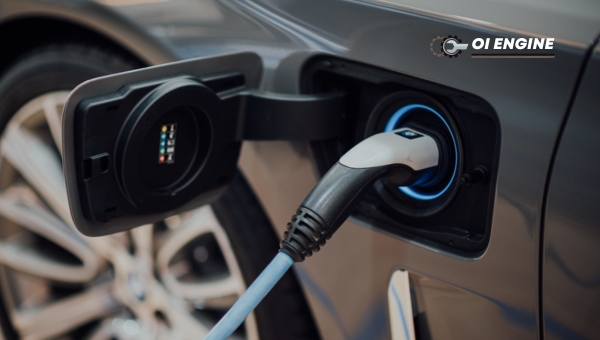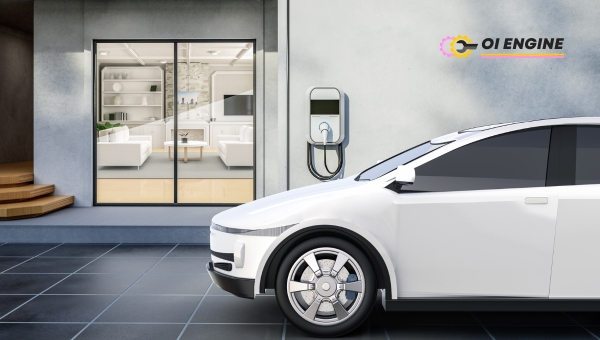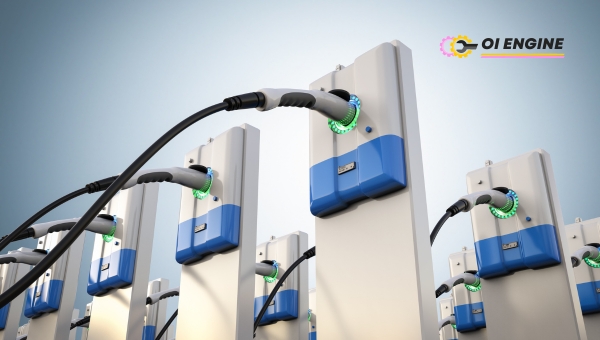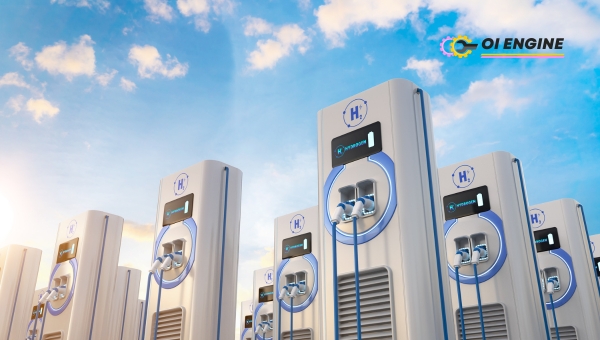When I think about the future of driving, my mind zooms straight to electric cars. They’re clean and cool, and they’re taking over the roads in California.
But there’s a twist – while California leads in EV chargers installing them left and right, it surprisingly lags when it comes to generating power from renewable sources.
You’d think a state known for its sunny beaches and love for all things eco-friendly would be all over that green energy life, but somehow it’s not quite there yet. Let’s dive into this electric riddle!
Sure, if you drive an electric car in California, you’ll find plenty of places to charge up. It’s like there is a charger popping up on every corner!
They’ve got this game down to a science; you could almost say they’re the kings of car charging stations – if only the same could be said about their renewable energy game!
Despite all those sunny days that are great for solar power and winds that could turn turbines like nobody’s business, California isn’t shining as bright in the renewable energy world as some other states. So yeah, charging your ride? No problemo. Powering everything else? That’s where the plot thickens.
California: The Leading State in EV Chargers
When it comes to electric vehicle (EV) chargers, California has taken the lead in this space. As someone who is paying attention to these trends, I’ve seen an impressive number of charging stations popping up all over the state.

People driving electric cars can find places to charge their vehicles more easily here than almost anywhere else in the United States.
The Phenomenal Growth of EV Chargers in California
In California, the growth of EV chargers has been nothing short of amazing. Several key points paint a clear picture of how fast this network is expanding:
- Numbers: The total count of EV chargers has skyrocketed with thousands available across the state.
- Locations: You’ll find them in public areas like shopping malls and government buildings, but also at many workplaces and houses.
- Types: The range includes standard chargers for regular use and fast chargers for quicker top-ups.
- Access: Most chargers are easy to get to and can be used by different brands and types of electric cars.
This rapid development means that if you drive an electric vehicle in California, chances are you won’t need to worry about running out of power.
Easy access changes how people think about driving; it’s one reason why more folks here are willing to switch from gas engines to clean electric vehicles.
Why California Leads in EV Chargers
Several reasons explain why California is out ahead when it comes to having lots of EV chargers:
- Supportive Policies: The government here offers incentives for setting up new charging stations and buying electric cars.
- Green Attitudes: Many people living in California care deeply about protecting our planet. So they support clean energy and ways to cut pollution from cars.
- Big Market: With a lot of drivers interested in going green, there’s a high demand for both electric vehicles and places to charge them up.
Thanks largely to these policies combined with positive public opinion and a strong market demand, we’re seeing more investment pour into infrastructure that supports clean transportation solutions like EVs.
Also Read: Pilot Car Insurance – Top Companies Revealed!
Challenges Facing Renewable Energy Growth
Despite California’s commendable position in electric vehicle (EV) chargers, the state faces some significant roadblocks when it comes to renewable energy. It has been an uphill battle for renewable energy to claim a substantial space in the overall energy mix, mainly due to a series of deterrents.
I’ll discuss two significant points: obstacles hindering renewable energy expansion and how various states surpass California’s progress in renewable energy.
Obstacles to Renewable Energy Expansion
In a picture-perfect world, everyone would switch to clean energy sources like wind, solar, or hydro-power without hesitation. However, there are numerous barriers which retard this expansion in California:
- Cost: Most upfront costs of establishing renewable projects are high and thus challenging for average consumers.
- Intermittency Issues: Unlike traditional power generated from coal or oil that can be produced continually, sources like solar and wind are intermittent.
- Storage Problems: There is an incredible need for cost-efficient and high-capacity storage systems to harness excess power in peak production times for later use.
- Infrastructure Constraints: The current electrical infrastructure is primarily designed for conventional power development. Upgrading it can often be expensive and time-consuming.
Compare Renewable Energy Progress Between California And Other States
While California’s lead in EV chargers is undeniable, the state’s renewable energy progress pales when compared to some other states.
Let’s take a closer look at how five of these states are faring better, even with similar or fewer resources:
- Iowa: Standing head-to-head with strong breezes far more frequently than we Californians ever see beach waves; Iowa produces 40% of its total electricity consumption from wind farms!
- Texas: Even with well-known associations with oil industry magnates, Texas has tremendously expanded into wind power investments over recent years; generating approximately 15% of its electricity needs through winds!
- Nevada: Neighboring Nevada also outruns us on sunny days; producing more than 13% of its power from solar energy.
- Okla: Oklahoma, a state with natural gas reserves, generates almost a third of its electricity through wind energy.
- Vermont: This might come as a surprise due to its small size, but Vermont is the greenest state with around 99% of total electricity production coming from renewable sources.
So it’s clear, that other states are making headways into renewable energy solutions quite impressive-like, even giving California a run for its money!
Underperforming Renewable Energy Sector
While California shines brilliantly with its EV charging network, it paradoxically casts a dim light in the arena of renewable energy.

To put it simply, California’s renewable energy sector is not keeping up with the times. Despite possessing abundant natural resources conducive to generating green energy, the state just can’t seem to muster sufficient momentum.
How Far Behind Is California’s Renewable Energy?
Compared to other states like Texas and Iowa, which are making huge strides in wind power generation, or even Arizona which has harnessed solar power effectively, California seems to be trailing behind.
Believe it or not, even though I reside in a region blessed with plenty of sunshine and wind that could be effortlessly transformed into power, we have yet to exploit these resources fully. Solar panels adorn a handful of rooftops and wind turbines are far from ubiquitous on our horizons.
Unfortunately, we’re falling behind on another aspect too – hydroelectric power generation. States like Washington and Oregon have surpassed us by generating more than double the amount of hydroelectric power we do!
It’s disheartening that despite possessing similar potential resources as these states for renewable energy creation (be it sun for solar power or streams and rivers for hydroelectric), California is lagging noticeably in this fundamental stage of the energy revolution.
Reasons Why California Lags In Renewable Energy
As troublesome as this situation might seem at first glance, there are very real reasons why our beloved Golden State finds itself caught in an unfortunate stride when it comes to renewable energy:
- Regulatory Barriers: The significantly stringent environmental regulations limit new developments.
- High Procurement Costs: Developing new infrastructure required for harnessing renewable sources can feel prohibitively expensive.
- Lack Of Effective Incentives: Despite existing incentives aimed at promoting green practices among consumers and businesses alike; they aren’t motivating enough.
- Obsolete Grid Infrastructure: The fact that our grid system is not up-to-date enough to handle the widespread generation and distribution of renewable energy.
- Public Opposition: Often, local communities oppose the construction of large-scale renewable energy projects due to concerns over aesthetics.
Despite these challenges, I genuinely believe California has the potential to lead in every aspect of green energy given its abundant natural resources.
It’s a matter of addressing these issues appropriately and making renewable energy more appealing and accessible to everyone.
Also Read: Top 12 Semi-Truck Financing Companies 2024
Policymakers Response To The Situation
In light of California’s contrasting performance in the fields of electric vehicle chargers and renewable energy, it’s crucial to see how policymakers are stepping up to address this discrepancy.

Their efforts primarily focus on designing strategies to escalate the use of renewable energy sources and also examine their impact on future advancements.
Strategies For Boosting The Adoption Of Renewable Energy
- Emphasize Energy Efficiency: The primary step taken by lawmakers is stressing the importance of energy efficiency. They aim for homes and businesses to use less power, thereby reducing the total electricity demand.
- Investments in Renewable Energy: Policymakers are pushing forward financial incentives to stimulate investments in renewable energy infrastructure. These include tax credits and grants that lessen the burden on individuals or corporations looking to invest.
- Legislation for Greener Building Codes: Another strategy aims at blending green practices into construction codes – compelling builders to integrate renewable energy applications like solar panels in building designs.
- Education and Public Awareness Campaigns: Lawmakers are also playing an essential role in raising public awareness about the benefits of renewable energy through various programs, school curriculums, and campaigns.
- Renewable Portfolio Standards (RPS): Policymakers have enacted these RPS which require utility providers to obtain a certain percentage of power from renewable sources, ensuring commitment towards cleaner energy alternatives.
Impact of Policies on Future Growth Trends
With these strategies in operation, they’ll inevitably influence growth trends in both EV charging stations and renewable energy. Five potential impacts strike as noteworthy:
- Increased Renewable Energy Usage: The stringent Renewable Portfolio Standards (RPS) could see a rising trend of renewable energy usage, overshadowing traditional electricity sources.
- Green Construction Boom: Legislation enforcing greener building codes may give way to more structures integrated with renewable application features, stimulating the construction industry to adopt greener practices.
- Greater Private Sector Involvement: With attractive financial incentives in place for investments in green energy projects, the private sector might show increased interest and lead to a surge of new developments.
- Increased Public Adoption of Renewable Energy: As public awareness widens, a noticeable upturn in residential PV installations or the use of solar-powered heaters and appliances can be expected.
- Improved Market for EVs: Since electric vehicles complement the renewable energy movement by being an environment-friendly alternative to conventional fuel-driven cars, we can anticipate an accompanying rise in demand for EVs and their charging infrastructure.
EV Charging Funding Plans 2025
Here is the table showcasing the funding plans in different states For EV charging vehicles:
| State | FY 2025 Funding | EV Charging Corridors (Miles) | NEVI Planning |
|---|---|---|---|
| Alabama | $16,892,384 | 1,002 | Alabama NEVI Planning |
| Alaska | $11,164,272 | 354 | Alaska NEVI Planning |
| Arizona | $16,290,816 | 1,158 | Arizona NEVI Planning |
| Arkansas | $11,527,783 | 512 | Arkansas NEVI Planning |
| California | $81,721,161 | 7,082 | California NEVI Planning |
| Colorado | $12,042,129 | 3,039 | Colorado NEVI Planning |
| Connecticut | $11,183,127 | 415 | Connecticut NEVI Planning |
| Delaware | $3,766,406 | 259 | Delaware NEVI Planning |
| District of Columbia | $3,552,666 | 27 | District of Columbia NEVI Planning |
| Florida | $42,185,543 | 6,244 | Florida NEVI Planning |
| Georgia | $28,749,258 | 1,523 | Georgia NEVI Planning |
| Hawaii | $3,765,855 | 788 | Hawaii NEVI Planning |
| Idaho | $6,368,404 | 1,974 | Idaho NEVI Planning |
| Illinois | $31,655,845 | 1,562 | Illinois NEVI Planning |
| Indiana | $21,215,670 | 1,436 | Indiana NEVI Planning |
| Iowa | $10,942,559 | 742 | Iowa NEVI Planning |
| Kansas | $8,414,042 | 1,417 | Kansas NEVI Planning |
| Kentucky | $14,793,815 | 1,469 | Kentucky NEVI Planning |
| Louisiana | $15,627,068 | 1,124 | Louisiana NEVI Planning |
| Maine | $4,110,072 | 1,105 | Maine NEVI Planning |
| Maryland | $13,380,134 | 1,139 | Maryland NEVI Planning |
| Massachusetts | $13,522,825 | 851 | Massachusetts NEVI Planning |
| Michigan | $23,442,756 | 2,167 | Michigan NEVI Planning |
| Minnesota | $14,518,886 | 562 | Minnesota NEVI Planning |
| Mississippi | $10,768,582 | 817 | Mississippi NEVI Planning |
| Missouri | $21,078,383 | 1,184 | Missouri NEVI Planning |
| Montana | $9,135,410 | 2,141 | Montana NEVI Planning |
| Nebraska | $6,435,652 | 480 | Nebraska NEVI Planning |
| Nevada | $8,085,017 | 2,446 | Nevada NEVI Planning |
| New Hampshire | $3,678,786 | 682 | New Hampshire NEVI Planning |
| New Jersey | $22,231,137 | 759 | New Jersey NEVI Planning |
| New Mexico | $8,176,486 | 2,128 | New Mexico NEVI Planning |
| New York | $37,373,747 | 2,034 | New York NEVI Planning |
| North Carolina | $23,221,768 | 2,075 | North Carolina NEVI Planning |
| North Dakota | $5,527,787 | 570 | North Dakota NEVI Planning |
| Ohio | $29,845,089 | 1,867 | Ohio NEVI Planning |
| Oklahoma | $14,121,021 | 1,955 | Oklahoma NEVI Planning |
| Oregon | $11,128,928 | 2,452 | Oregon NEVI Planning |
| Pennsylvania | $36,531,901 | 2,056 | Pennsylvania NEVI Planning |
| Puerto Rico | $2,909,472 | 212 | |
| Rhode Island | $4,869,410 | 44 | Rhode Island NEVI Planning |
| South Carolina | $14,909,490 | 759 | South Carolina NEVI Planning |
| South Dakota | $6,279,116 | 678 | South Dakota NEVI Planning |
| Tennessee | $18,815,036 | 1,283 | Tennessee NEVI Planning |
| Texas | $86,854,582 | 3,615 | Texas NEVI Planning |
| Utah | $7,731,474 | 1,220 | Utah NEVI Planning |
| Vermont | $4,518,882 | 549 | Vermont NEVI Planning |
| Virginia | $22,657,740 | 1,080 | Virginia NEVI Planning |
| Washington | $15,094,052 | 1,258 | Washington NEVI Planning |
| West Virginia | $9,730,352 | 548 | West Virginia NEVI Planning |
| Wisconsin | $16,753,173 | 2,066 | Wisconsin NEVI Planning |
| Wyoming | $5,704,051 | 911 | Wyoming NEVI Planning |
Also Read: How To Get A CDL – Your Ultimate Guide!
FAQs
Why does California need a lot more vehicle chargers?
California is home to the largest number of electric cars in the U.S., hence the growing need for more EV chargers. This will ensure driving an electric vehicle in California becomes as smooth and convenient as possible.
How many EV chargers does California have?
California currently boasts over 60,000 public and private charging outlets. But with the growing market for electric cars, there’s a demand for even more charging stations.
Why do so many EV chargers not work?
Some of the reasons why EV chargers may sometimes not work are due to technical glitches, maintenance issues or they may be currently engaged by other vehicles. There are initiatives aimed at improving this situation.
Has California run 100% on renewable energy?
No, although California has made significant strides towards transitioning into renewable energy sources like wind and solar power, it has not yet managed to function fully on these resources alone.
Is California a leader in renewable energy?
Through its ambitious clean-energy policies and goals, Green attitudes & dedicated efforts; yes! While it’s true that CA leads in some sectors such as solar power; however it still lags behind some other states in various indices linked to renewable energy usage overall.
Also Read: Safeguard With Physical Damage Insurance Coverage
Conclusion
As I examine California’s energy landscape, it becomes evident that the state leads substantially in the sector of electric vehicle chargers, lending a significant boost to green transportation.
However, when it comes to renewable energy, California leaves much to be desired. Factors such as policy shortcomings and other obstructions continue to impede the growth of renewables.
Despite these hurdles, lawmakers show commitment to powering a brighter and cleaner future for all its residents. Time will tell how policies shape trends in both EV charging stations and renewable energy sectors.
